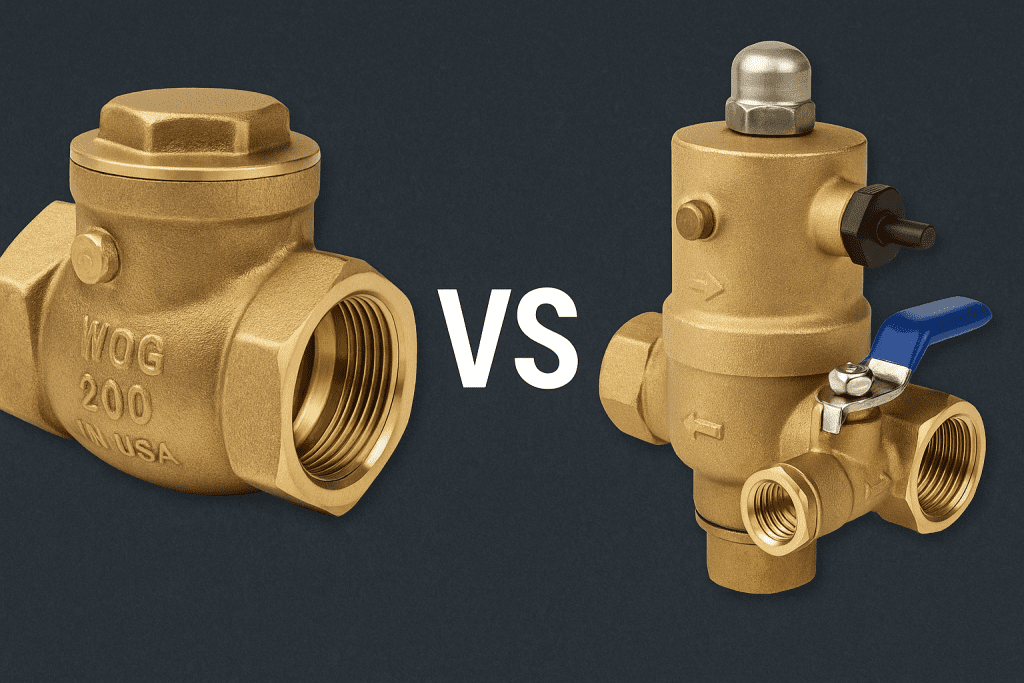
Ever stood in a hardware store or browsed online and stumbled across check valves and backflow preventers, only to wonder… what’s the difference? They both stop water from flowing backward, right?
Well—yes, but not exactly in the same way. And that difference matters more than most people realize, especially when we’re talking about the water you drink.
This guide lays out everything you need to know. No fluff, no tech speak—just a clear explanation that’ll help you figure out what you need and why.
So, What’s a Check Valve?
A check valve is a pretty basic plumbing part. It’s built to let water flow in one direction only. When water moves forward, it pushes the valve open. If the water tries to go backward, the valve shuts automatically.
There are a few types, but the idea stays the same:
- Swing check valve – uses a flap that swings open and closed.
- Spring check valve – relies on a spring for quicker response.
- Ball check valve – uses a ball inside that moves with the flow.
These are super common in things like:
- Booster pumps
- Sump pumps
- HVAC systems
- Some pool and spa setups
In short: check valves keep water moving in one direction, and that’s about it. They don’t block contamination. They don’t release pressure. They just open and close.
What About a Backflow Preventer?
Now here’s where things go deeper.
A backflow preventer is designed to protect your drinking water. It also stops reverse flow—but it does more than that. It blocks any polluted or non-drinkable water from getting pulled back into the clean water supply.
A few common types of backflow preventers include:
- AVB (Atmospheric Vacuum Breaker) – simple device often used for garden hose connections.
- DCVA (Double Check Valve Assembly) – two check valves back-to-back. Decent protection for lower-risk setups like sprinkler systems.
- RPZ (Reduced Pressure Zone) – the gold standard. Two check valves plus a pressure relief valve between them. Required in high-risk or commercial situations.
You’ll usually see backflow preventers installed on:
- Lawn irrigation systems
- Fire sprinkler lines
- Commercial dishwashers and kitchens
- Medical buildings
- Anything hooked up to city water that could risk contamination
Check Valve vs Backflow Preventer — Quick Comparison
Let’s make this easy.
| Feature | Check Valve | Backflow Preventer |
|---|---|---|
| Purpose | One-way water flow | One-way flow + protects clean water |
| Used In | Pumps, closed loops, non-drinking lines | Irrigation, city water, fire protection |
| Complexity | Very basic | More advanced, safety-focused |
| Code Approved for Drinking Water? | No | Yes |
| Price | Low | Higher, but with safety built-in |
Think of a check valve as a door that swings shut if water turns around.
A backflow preventer is that door—plus a sensor, a backup plan, and a pressure release.
Which One Do You Actually Need?
Here’s the rule of thumb:
If the water in your system touches anything that could go into your drinking water, don’t risk it. Use a backflow preventer.
Choose a check valve if:
- You’re working with a sump pump or pool line
- It’s a closed system that doesn’t mix with clean water
- You just want to stop backflow without all the bells and whistles
Use a backflow preventer if:
- You’re tapping into city water
- You have an irrigation system or hose that can sit in standing water
- You’re running a system that local plumbing code says needs protection
Spoiler: most cities require backflow preventers for any system tied to a municipal water line. And they don’t consider check valves enough protection.
Real Example? Sure.
Let’s say you have a sprinkler system in your yard. After a day of watering, the sprinkler heads are sitting in a muddy lawn. If the city suddenly loses water pressure—like from a fire hydrant opening nearby—that dirty lawn water could be pulled backward into the water supply.
With a check valve, there’s no guarantee it would stop that.
A backflow preventer? It’s made to handle that exact scenario.
What the Code Says
Plumbing codes across North America (and most other countries) are pretty clear. If there’s a chance that non-drinkable water could enter a drinking water supply, you need a backflow preventer.
The Environmental Protection Agency (EPA) and local authorities don’t consider check valves strong enough for cross-connection control. In fact, many places require annual backflow testing for certain setups.
And if you’re renting or running a commercial space, it’s not even a question—it’s mandatory.
People Also Ask:
Can a check valve be used in place of a backflow preventer?
No. Not where water safety is concerned. A check valve doesn’t meet the safety or legal standards for preventing contamination.
Do all backflow preventers have check valves?
Yes, they do. But they have more than just that—extra valves, air gaps, or pressure reliefs.
Why are backflow preventers so expensive?
Because they’re designed to prevent real, dangerous problems—and most models need testing and certification. Think of it like insurance for your water.
Bottom Line
Here’s the simplest way to remember it:
A check valve keeps water moving the right way.
A backflow preventer keeps your water safe.
They might seem similar, but they solve very different problems. One is basic. The other is a built-in safety net for your home or building—and in many cases, a legal requirement.
If in doubt? Always go with the backflow preventer. Your water—and your local plumbing inspector—will thank you.
Author
-

James is a certified backflow specialist with over 20 years of hands-on experience in plumbing safety.
He’s passionate about educating homeowners and businesses on the importance of clean water systems.
James simplifies complex maintenance tips through clear, practical advice.
When he's not writing, you'll find him inspecting valves or training the next generation of backflow testers.

